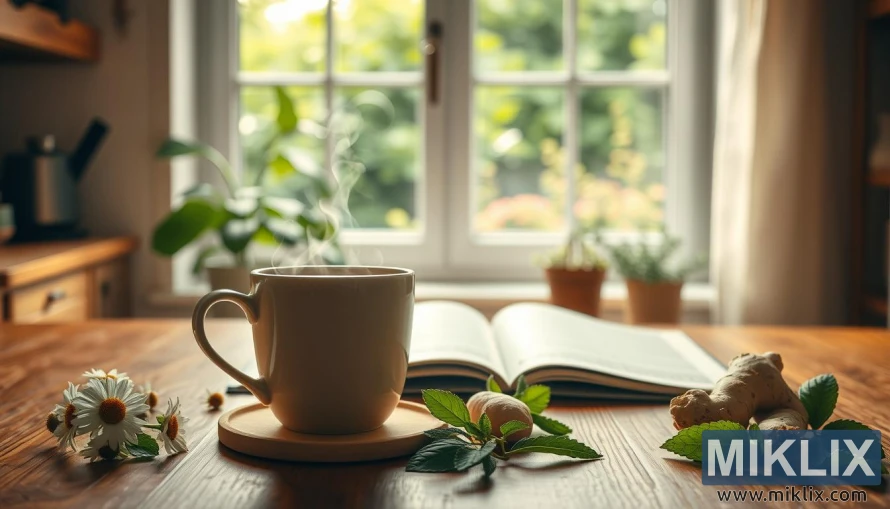Image: Herbal tea for digestive wellness
Published: May 16, 2025 at 12:24:58 PM UTC
Last updated: September 25, 2025 at 8:20:16 PM UTC
Cozy kitchen scene with steaming herbal tea, chamomile, mint, ginger, and an open book on digestive health, set against a lush garden backdrop.
The image captures a moment of stillness and gentle comfort, set in a kitchen space that radiates warmth and quiet beauty. At the center of the composition, a simple ceramic cup sits on a smooth wooden table, its shape clean and inviting, steam curling delicately upward in wisps that speak of freshly brewed herbal tea. The muted, natural tones of the cup blend seamlessly with the earthy wood beneath it, creating a harmonious balance that places emphasis not on extravagance but on simplicity and authenticity. The tea, though hidden inside the vessel, makes its presence known through the rising vapor and the carefully arranged botanicals surrounding it, each ingredient whispering of the healthful and soothing qualities it brings.
Scattered thoughtfully across the table are sprigs of chamomile with their small white petals and cheerful golden centers, instantly recognizable as one of the most calming and restorative herbs. Their delicate blooms suggest relaxation and ease, qualities often associated with evening rituals of winding down after a long day. Alongside them lies a cluster of fresh mint leaves, vibrant and textured, their bright green hues signaling freshness and clarity. The crispness of mint offers a natural counterpoint to the gentle sweetness of chamomile, balancing the herbal composition with its invigorating character. A piece of fresh ginger root completes the trio, its knobby surface and pale golden color evoking warmth, resilience, and centuries of traditional use for digestive health and healing. Together, these botanicals form a circle of care around the cup, as though nature itself is contributing to the nourishing brew within.
The table also holds an open book, its pages inviting yet unobtrusive, suggesting a quiet pursuit of knowledge or reflection. Though the text is not the focal point, its presence carries meaning, hinting at the link between tea drinking and a mindful understanding of wellness. Perhaps the book references the digestive benefits of these very herbs—how chamomile soothes, mint refreshes, and ginger strengthens the stomach and supports balance. Its open pages symbolize a willingness to learn and to connect tradition with mindful living, making the ritual of tea not just one of comfort but also of conscious care for the body.
Behind this serene tableau stretches the soft blur of a window view, filling the background with the impression of lush greenery. A garden, vibrant and thriving, is hinted at beyond the glass panes, its foliage bathed in natural light. This connection to the outdoors reinforces the origin of the herbs on the table, grounding the scene in the cycles of growth and renewal. The potted plants visible on the windowsill bring this sense of life even closer, suggesting a kitchen where nature and nourishment are always within reach. The window not only provides light but also serves as a portal to tranquility, opening the indoor space to the calm energy of the natural world outside.
The light itself is warm, golden, and unhurried, illuminating the wooden textures of the table and casting a soft glow over the cup, the herbs, and the book. It creates an atmosphere that is neither stark nor dramatic but gently embracing, wrapping the scene in comfort. Shadows fall lightly and naturally, lending depth without intruding, as if time itself has slowed to allow this simple moment of wellness to unfold. The interplay of warmth, natural elements, and stillness combines to evoke an experience that is not just visual but sensory—a steaming cup waiting to be cradled, the scent of chamomile and mint mingling with ginger’s spice, the sound of leaves rustling outside the window faintly echoing within.
Altogether, the image conveys more than just a beverage; it portrays a ritual of self-care, a moment carved out for restoration. It speaks to the intimate connection between tea and well-being, the way a humble cup infused with nature’s gifts can bring comfort, support the body, and provide calm in the midst of life’s demands. It is a reminder that healing often comes not from complexity but from simplicity: a few herbs, a warm drink, a quiet space, and the presence to enjoy them fully. The scene invites the viewer to pause, breathe, and embrace the nourishing, grounding properties of tea—not just as a drink but as a daily ceremony of balance and renewal.
The image is related to: From Leaves to Life: How Tea Transforms Your Health

